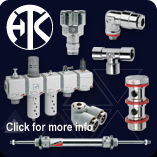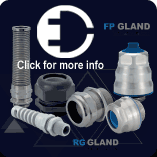Formulas of Power Engineering
|
Cross-section
for direct - and single phase alternating current
(current given)
| q = |
1 x I x l |
(mm²) |
| κ x u |
| |
|
|
| for three-phase current |
| q = |
1.732 x I x cosφ x l |
(mm²) |
| κ x u |
for direct - and single phase alternating current
(capacity given)
| q = |
2 x I x P |
(mm²) |
| κ x u x U |
| |
|
|
| for three-phase current |
| q = |
l x P |
(mm²) |
| κ x u x U |
Voltage drop
For low voltage cable network of normal operation, a voltage drop of 3-5% is adviseable.
Exeption: higher values (7%) can be permitted in case of network extension or in short circuit.
for direct current (current given)
single phase alternating current (current given)
| u = |
2 x I x cosφ x l |
(V) |
| κ x q |
for three-phase current
(current given)
| u = |
1.732 x I x cosφ x l |
(V) |
| κ x q |
for direct current (capacity given)
| u = |
2 x l x P |
(V) |
| κ x q x U |
single phase alternating current (capacity given)
| u = |
2 x l x P |
(V) |
| κ x q x U |
for three-phase current (capacity given)
|
| u |
= |
Voltage drop (V) |
| U |
= |
Operating voltage (V) |
| P |
= |
Power (W) |
| RW |
= |
Effective resistance (Ω/km) |
| L |
= |
Inductance (mH/km) |
| ωL |
= |
Inductive resistance (Ω/km) |
| |
|
ω = 2 π f at 50 Hz = 314 |
| q |
= |
Cross-section (mm²) |
| I |
= |
Working current (A) |
| l |
= |
Length of line (m) |
| κ |
= |
Electrical conductivity of conductors |
| |
|
(m/Ω x mm²) |
| |
|
κ Copper: 58 |
| |
|
κ Aluminum: 33 |
|
Nominal voltage
The nominal voltage is to be expressed with two values of alternating current U0/U (in V).
| U0 |
= |
voltage between conducter and ground or metallic covering (shield, armoring, concentric conductor) |
| U |
= |
voltage between two outer conductors |
| U0 |
= |
U/√3 for three-phase current systems |
| U0 |
= |
U/2 for single phase and direct current systems |
| U0/U0 |
= |
1 outer conductor is grounded for single phase and direct current systems |
|
Nominal current
I in A
Active current
IW = I x cosφ
Reactive current
I0 = I x sin φ
Active power
S = U x I for single phase current
S = 1.732 x U x I for three-phase current
Apparent power
P = U x I x cosφ for single phase current
P = 1.732 x U x I x cos φ for three-phase current
P = U x I for direct current
Reactive power
Q = U x I x sin φ for single phase current
Q = 1.732 x U x I x sin φ for three-phase current
(Voltampere reactive) Q = P x tan φ
Phase angle
φ is a phase angle between voltage and current
| cos φ |
= |
1.0 |
0.9 |
0.8 |
0.7 |
0.6 |
0.5 |
|
| sin φ |
= |
0 |
0.44 |
0.6 |
0.71 |
0.8 |
0.87 |
|
|
Insulation resistance
| RInsu = |
SInsu |
x In |
Da |
x 10-8 (MΩ x km) |
| l |
d |
Specific insulation resistance
| RS = |
R x 2π x l x 108 |
| In |
Da |
| di |
|
| Da |
= |
Outer diameter over insulation |
| d |
= |
Conductor diameter |
| di |
= |
Inner diameter of insulation |
| l |
= |
Length of the line |
| SInsu |
= |
Spec. resistance of insulation materials (Ω x cm) |
|
Mutual capacity
for single conductor, three-cond. and H-cable
| CB = |
ξr x 10³ |
(nF/km) |
| 18 In |
Da |
| d |
Inductance
single-phase
| 0.4 x ( In |
Da |
+ 0.25) mH/km |
| r |
three-phase
| 0.2 x ( In |
Da |
+ 0.25) mH/km |
| r |
|
| Da |
= |
Distance mid to mid of both conductors |
| r |
= |
Conductor radius |
| ξr |
= |
Dielectric constant |
| 0.25 |
= |
Factor for low frequency |
|
Ground capacitance
EC = 0.6 x CB
Charging current
(only for three-phase)
ILad = U x 2 π f x CB x 10-6 (A/km per conductor at 50Hz)
Charging power
PLad = ILad x U
Leakage and loss factor
G = tanδ x ωC(S)
tanδ = G/ωC
|
| ω |
= |
2 π f |
| C |
= |
Capacity |
| tanδ |
= |
Loss factor |
| S |
= |
Siemens = 1/1Ω |
|
Dielectric loss
DV = U² U x 2 π f x CB x tan x 10-6 (W/km)
It should be noted that for the current load of the insulated cables and wires of selected cross-section, the power ratings are to be considered.
To estimate the voltage drop of insulated cables and wires with large cross-sections of single and three-phase overhead line, the active resistance as well as indictive resistance must be considered.
Formula for single phase:
U = 2 x l x I x (RW x cosφ + ωLx sinφ) x 10-3 (V)
Formula for three-phase
U = 1.732 x l x I x (RW x cosφ + ωLx sinφ) x 10-3 (V) |
f at 50Hz
| tanδ PE/VPE cables |
~ 0.0005 |
| EPR |
~ 0.005 |
| Paper single conductor, three-conductor, H-cable |
~ 0.003 |
| Oil-filled and pressure cable |
~ 0.003 |
| PVC-cable |
~ 0.05 |
|

















